Up early morning. With the street sweepers.

Up early morning. With the street sweepers.


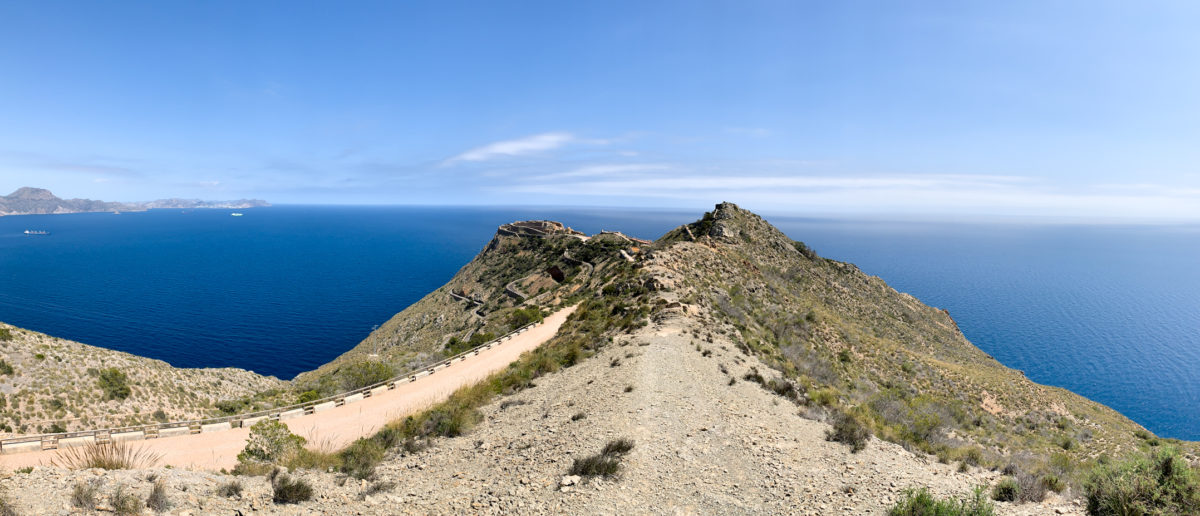
Dear Friends,
I wanted to write this for a week now. The boat keeps us busy with 10 to 12 hour work days.
This blog entry will be short -more photos than text, which in this case makes sense anyway. Photographing landscape becomes easy with deep blue skies and sunshine. In this region of Spain the sun shines for 330 days per year or so.
We went to the ‘Battery Castillitos’ west of Cartagena. See more under: http://www.castles.nl/castillitos-battery and https://es.wikipedia.org/wiki/Bater%C3%ADa_de_Castillitos
Pretty mountain roads going up and down. After every bend on the road opens another splendid view. Sometimes we just stopped, sat on a rock and soaked the view in. It was a great day!












Last weekend we travelled east by car for a little sightseeing. Lunara is in a boat yard and after many 12 hour work days in the yard, we were ready for a little rest and relaxing. On Saturday we drove a short distance to the east and Sunday to the west (separate blog entry coming up later)

A very interesting drive along the port on a winding road uphill, later on a high cliff with great views of the port and the coast line on the other side of the bay, all in-between passing through short tunnels.

Then we entered Escombreras, a huge industrial area and port with refineries, cement factories and left over buildings from mining centuries ago. The landscape is barren and plastered with huge ball shaped gas tanks dotting the hillside for miles mixed with silvery shining pipes in front of a brownish landscape. It’s sci-fi looking, exactly how I would imagine a doomsday settlement on Mars. It was difficult to photograph, wanting to say below does not reflect properly the view.

We off-roaded our Fiat Panda rental car through a silver and lead mining area from the last century. Ruins of an industrial era gone by. We were heading for the beach ‘Playa El Gorguel’.





The beach and bay was scenic. Along the east side of the cliff were shacks. No running water or electricity and most residences seemed to be modest vacation spots. Nearly the whole bay’s entrance was blocked by a fish farm set some hundred meters from the beach. The sand was blackish.

Nevertheless it is scenic, interesting and weirdly fascinating.




Portmán
After El Gorguel we followed the dirt road further east. Portmán was initially a first century roman enclave used mostly for mining. Mining continued into the 1980s. Many hundred millions of tons of mining residuals and chemicals were dumped into the bay. The fishing port, because of all the deposits, disappeared and a new, smaller port was built on the east side of the bay. However, this port is small and the entrance so silted and narrow we could nearly walk over the port entrance.

The prime real estate of the bay and beach area have become catch basins for the open mining deposits and waste which still wash out from up the valley 40 years later. The french mining company disappeared after mining became unprofitable and left without cleaning up the area which they were contractually required to do. The EU and Spain spent 80million Euros since 2011 in the cleanup effort. Still, the little hamlet looks destroyed for one or two more generations of Portmán citizens. As it is, Portmán could have lived of tourism probably better than mining, but not today.

Side note:
Our boat is in repairs, but we are in better shape than below 🙂

That’s it for today. Bye, bye.
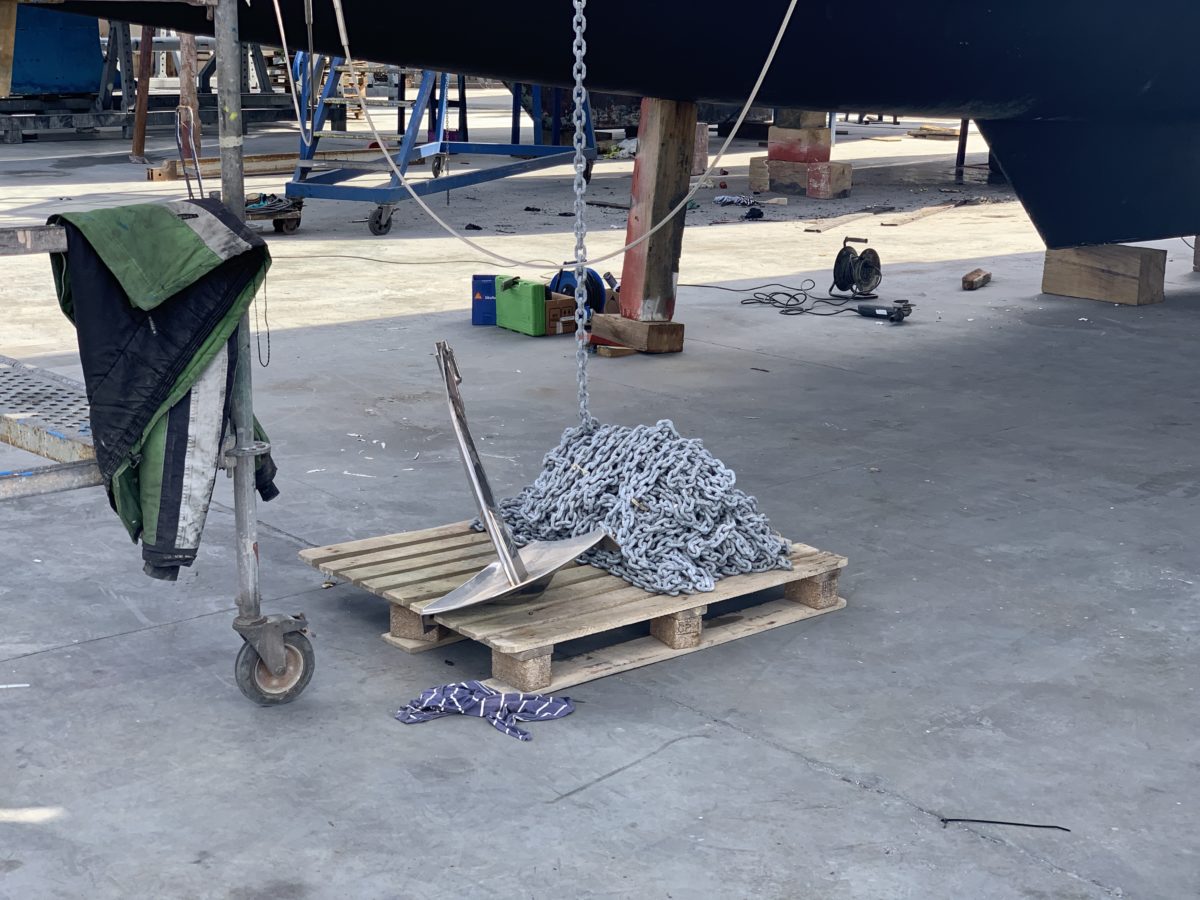
We are at ASCARS shipyard in Cartagena and despite it’s Saturday, the work continues. Quality of work so far is impressive and their willingness to understand what the customer wants is great here. Management speaks excellent english and is always outside on the yard to inspect the ongoing work on all the boats here. Large and small customers gets treated equally well.
I keep it short this morning as I have to return to the yard soon. These pictures were pre breakfast (mine). They start early here!
Below just some photos from ASCARs work




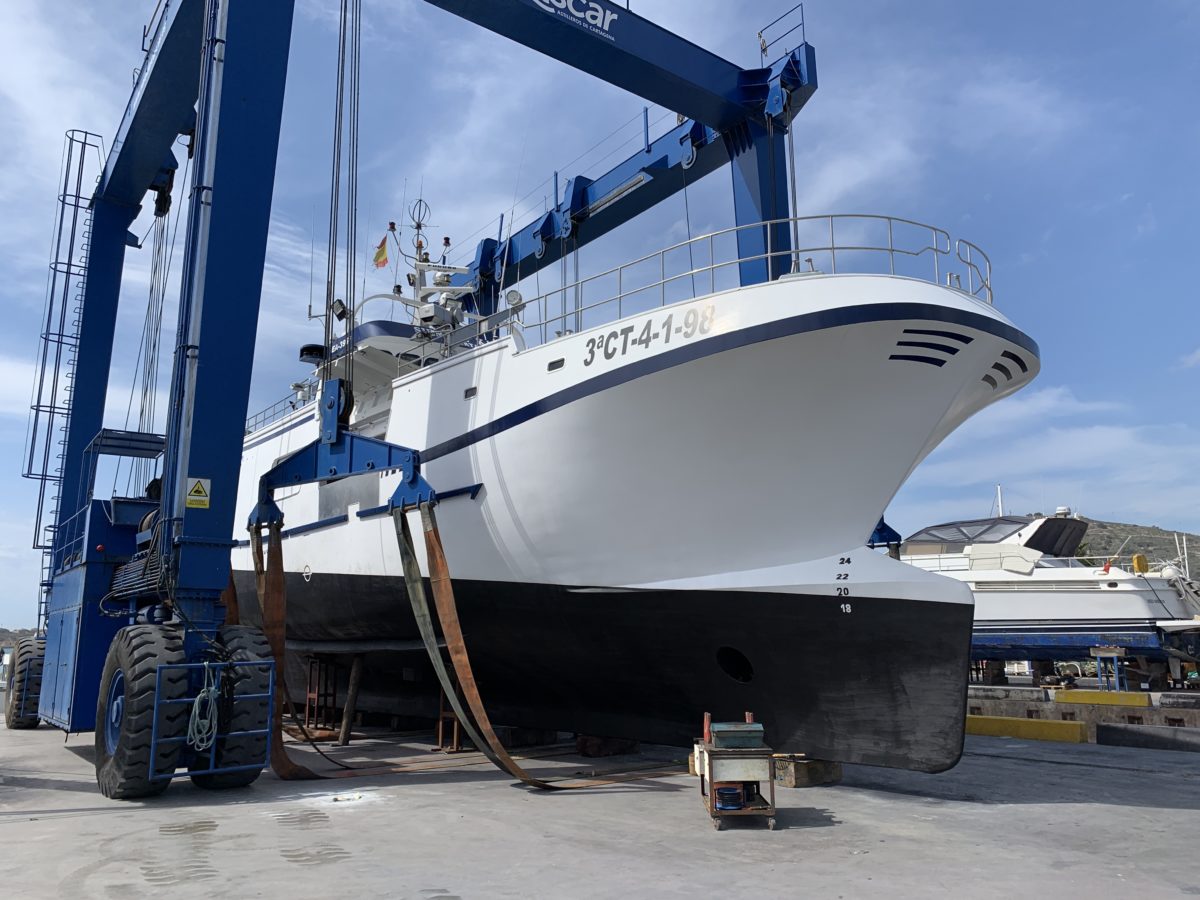
Boat yards have their Charme. Not necessarily in a warm and fuzzy feeling way, but interesting. That aside, we have some work to do. While the boat is messy anyway, we use the opportunity for repairs we didn’t dare to do in a clean marina.

The Admiral works on our ball bearing sail cars. Those are the devices which connect the main sail to the mast and allow it to slide up and down – or so goes the theory. Up yes, down not so much.
The Admiral cleans, inspects, oils and reinsert the cars onto the track. Very fiddly as the balls don’t want to follow the orders of the Admiral.

I dropped the rudders with the help of a friend. We want to inspect the shafts and ensure that we do not have any signs of damage from stray electrical currents. You might remember we had some wiring errors. We will also inspect the saildrives. All non bronze thruhulls will be exchanged in order to be safe.

We are working at the dreaded windows again. They started to leak shortly after the repair in Southern France. The 1.7m long windows became unglued in heavy weather. Catamarans flex in waves and and the windows are simply too long. We cut them in half and glued the two pieces into the cutout. The cut center rests now on a fiberglas bridge with a 10mm gap. There should be ample room for them to move when underway. The glue becoming undone should be a thing of the past – I know famous last words 🙂

Our crash boxes had water leaking in from the so called dolphin stays. We will reinforce the area with some layers of roving glas fiber mats and should be fine afterwards.

I am heading back to the boatyard, got called and have to break of here.
Bye
Scheduled Underwater Inspection
Changing 2 sea-valves and thruhulls with a ‘problematic’ installation method. We hope to splash early next week. 

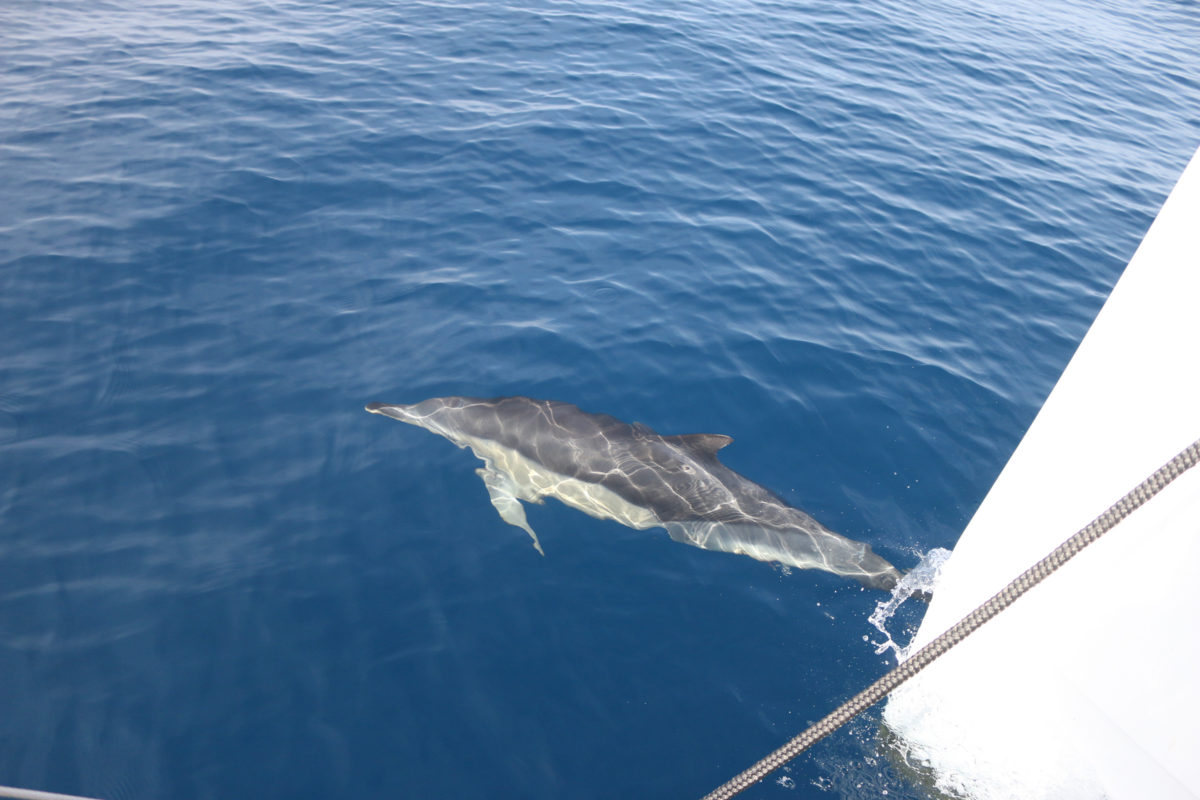
Initially we planned to sail straight to Cartagena, Spain which is a 48hours+ trip. The weather forecast made it wise to to split the journey into two legs. Wind and waves for the second night were not what we consider nice.
I am writing part of this underway update during my night watch. It’s midnight right now (local time). By the time this blog update is published we will be in Denia.
The wind is variable from 2kts to 8kts. We have the port engine running.
It’s a very quiet watch with occasional commercial traffic. I prefer night watches with some action, as it is so much easier to stay awake.
At the moment one vessel is overtaking us. “Atlantic Island”, a small cargo vessel is catching us from behind with a 3.8kts relative speed. You can see him near the 3nm ring on the radar

But back to the beginning. In the last days before our departure we finally got some of the spare parts we needed. In the end we stayed 4 weeks in Roda de Bara and were very happy about the location, not so happy about the waiting.

The marina facility is in good shape. The people in the marina and Capitaneri are very friendly. We met some cool liveaboards on our dock. And Francis from the local chandlery is a gem. We will return one day.
We explored the nearby coastal town of Sitges, which we highly recommend, see our earlier post.
We also visited a large Cava winery. Now, for those who judge Cava by what they can buy outside Spain, please reconsider. Let me encourage you to try again when you visit Spain. We saw the cellars of ‘Freixenet’. The 1910 brickstone architecture of the vinery is set in a nice landscape and felt inviting.

Cava is the Spanish equivalent to Champagne. Beyond the budget product made for export they produce excellent brut sparkling Cavas of many varieties. Freixenet’s reception has wine tasting booths with sofas in a round setting for your group or family. Together with some plates of acorn fed Iberico ham and other tasty snacks you get a great combination to try.

Back to the boat and sailing. This morning, hours before leaving, I reinstalled the autopilot controller in the engine room. The generator is decommisioned at the moment and will not be used on this trip. Beyond the issues I found earlier, which help explain the constant overheating, I researched the problem further and believe now that we whole cooling/water supply installation is insufficient to run our genset in a healthy mode.
We epoxied yesterday the mounting plate in the engine room. Today we can mount the autopilot controller box in a solid fashion.

And while being at it, I filled all the little holes in the hull, drilled for unknown reasons by unknown technicians.

Pictured above the epoxy shop on our outside dining table. The Admiral loves it when I use here kitchen gadgets like the electronic scale for work like this.
By now we are underway to Denia. After leaving the dock it typically takes an hour to clear the deck from fenders, lines and gangway, including making everything sea-safe and hoisting the sails.

Then we further waterproof the boat from above. From an aerial view our boat looks a piece of art from a trailer park. Admiral Christo @ work!

The story is that one top window started leaking again. Duct Tape is our new friend. When I retrieved a new roll from the locker I realized that this was roll #3 which means we had already duct-taped 100meters on our boat. Later analysis in port showed that the window cutout in the deck is not 100% straight and even. When the boat flexes in waves the silicone glue must compensate the different movements by stretching. With an uneven thickness, ergo being thin in some areas, the thinner part of the silicon glue overstretches and detaches from the gelcoat and ….. we are leaking from top.
Afterwards the Admiral unfolded her favorite chair on the front deck and read a book in the sunshine.
Early morning the next day, we crossed the deepest part on this trip -1276m or 4200feet.

Later in the morning a pod of dolphins visited us for 15minutes. They swam and played around under our bow. I am not sure, but it looked like they rubbed their belly and back on the soft roundings of the bow, all while we were cruising along at 6knots


The Admiral was off watch and sleeping, so I did not want to wake her up. Last time I did this, she came out and the dolphins were gone. After a while looking at this beautyful scene under our bows I caved in and woke her up. The moment she came out – quite excited and in PJs- she could see only one dolphin far back in our wake. What shall I do next time?
As we approached Denia the ship traffic increased. See the radar from 10miles out

Denia is a ferry port and home to a small fishing fleet. The ferries go mostly to Ibiza and the Balearic Islands. Some are quite fast. When you see them on radar or get the AIS warning things happen fast. You can barely see them at 2mi away, but with a closing speed of 30kts you will be in their way in 4 minutes!
The port entrance of Denia is a narrow channel which is easy to navigate in good weather. When we left on the following day it looked quite different and more challenging.

Why we split the trip into two legs you can see here. The weather we wanted to avoid begins to roll in an hour after our arrival.

The marina is nice but pricey. The views are great, especially towards the fort. With sunshine it must be beautiful here.

In the evening we took a small free ferry across the port to go to the old town for dinner.
We found a nice grill restaurant. The food was freshly grilled in the center of the restaurant, protected by glass screens and equipped with good ventilation. Food was really tasty and the local Spanish Rose was excellent.

Tomorrow we’ll get up late and prepare to leave around 1400h heading to Cartagena. More about this in the next underway update.

Admiral fueling up.
Weather lousy.
Crossing seas with light wind and rain. Better days will come 😀.
Denia port entrance had breaking waves on each side. The middle part of the channel was fine. Outside the first hour exposed us to a heavy long swell from a gale in the east and crossing wind waves. Rain and fog with limited visibility. Sailing with intense use of the Radar. After rounding the Cape Cabo de la Nao for a westerly heading life onboard became much easier.
Arrived 1700h on Friday in Cartagena. It’s chilly here. Weather in the Med, so everyone on the dock declares, is unusually crazy.
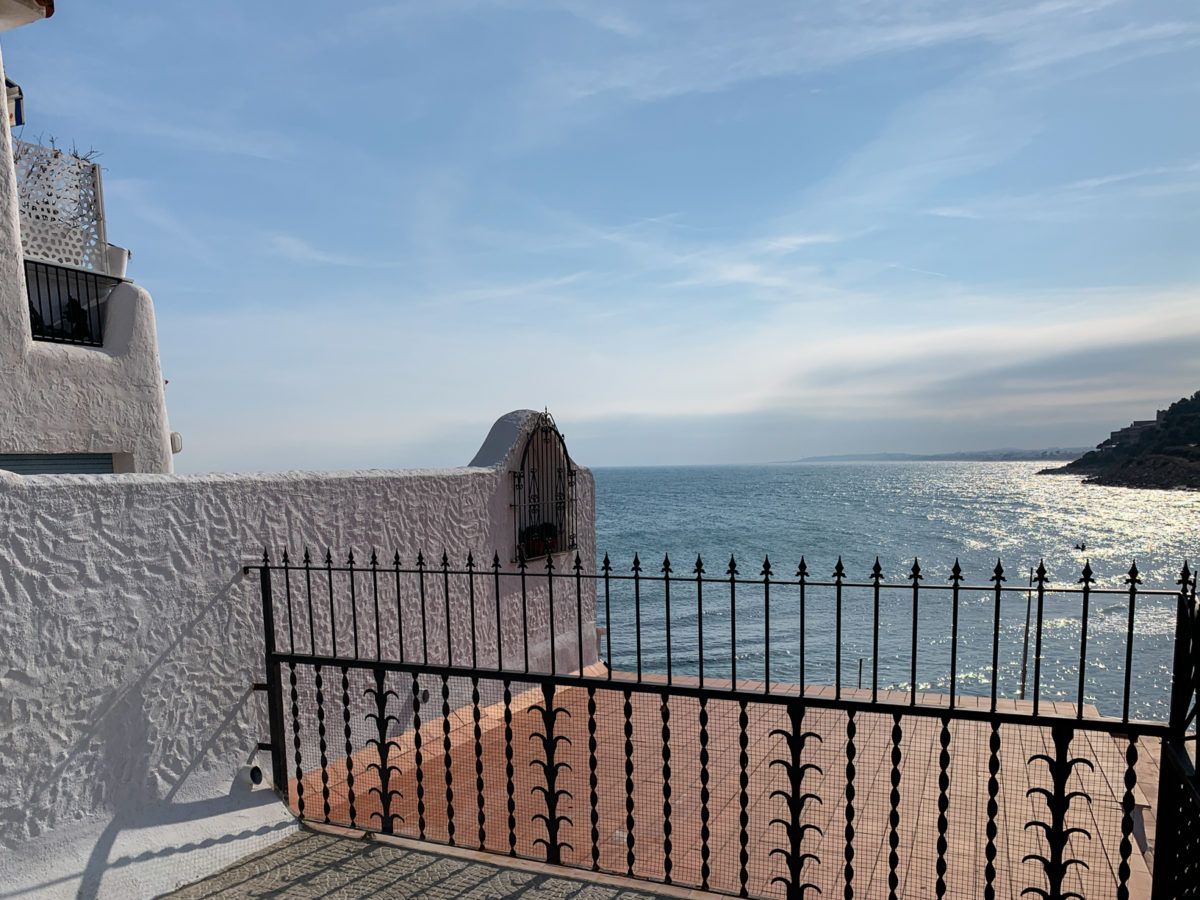
Just some pictures from our Sunday afternoon walk. Couldn’t resist to post as it is so beautiful here.
In some days we will continue our journey towards Cartagena.


